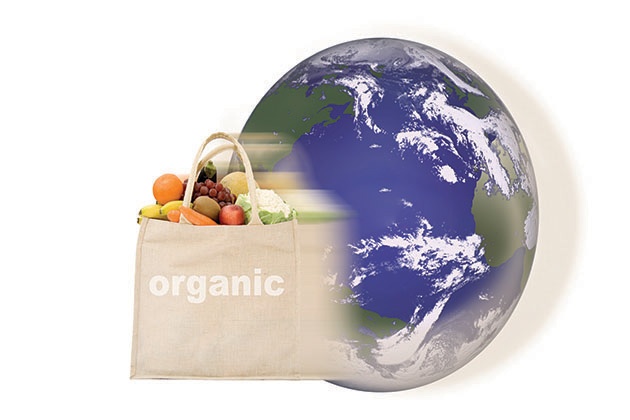Study shows growing food organically has higher impact on آب و ہوا because of more land use
نامیاتی food has become very popular in the last decade as consumers are becoming more aware and health and quality conscious. نامیاتی food is produced naturally from نامیاتی کاشتکاری which aims to increase the naturalness of food by minimizing chemical interference when producing it. So, نامیاتی food does not include any pesticides, synthetic fertilizers or other artificial additives. The produce of meat, eggs and other products from animals, is termed نامیاتی if animals were not subjected to any antibiotics or growth hormone supplements. Every food item produced organically is also more expensive than conventional food because without use of chemicals or additives, it takes longer time to produce نامیاتی food and thus requires more resources in terms of land, time etc. The demand for نامیاتی خوراک is certainly higher and rapidly growing compared to the supply which is further contributing to high prices of نامیاتی کھانا.
Conventional farming vs نامیاتی کاشتکاری
چلمرز یونیورسٹی آف ٹیکنالوجی، سویڈن کے محققین نے اثرات کا تجزیہ کرنے کے لیے ایک نیا طریقہ کار تیار کیا۔ نامیاتی کاشتکاری on آب و ہوا via the factor of land-use by comparing conventional food production in agriculture with نامیاتی production. Their study showed that producing نامیاتی food contributed to higher emissions into the ماحول. مثال کے طور پر، نامیاتی peas farmed in Sweden had almost 50 percent higher impact on آب و ہوا while for other foods like Swedish winter wheat this number was as high as 70 percent. This is attributed to two reasons; first, to the more land required for نامیاتی farming and second, since fertilizers are not used in نامیاتی farming the yields per hectare is considerably reduced. For every single food product, be it organic meat or dairy product the land required is much more for organic production compared to conventional کاشتکاری. This greater land use automatically leads to higher carbon dioxide (CO2) emissions because for every land which needs to be cultivated, forests are converted by cutting trees leading to deforestation. Deforestation accounts for 15 percent of total greenhouse emissions on our سیارے. Simply put, felling of trees is doing an irreversible damage to the environment and to the ecosystem (flora and fauna).
'کاربن مواقع کی قیمت'
میں شائع ہونے والی ان کی تحقیق میں نیچر محققین نے پہلی بار 'کاربن مواقع کی لاگت' نامی ایک نئی میٹرک کا استعمال کیا جو زمین کے زیادہ استعمال کے اثرات کے ذریعے کاربن فوٹ پرنٹ کا جائزہ لیتا ہے اور اس نے جنگلات کی کٹائی سے CO2 کے اخراج میں کس طرح تعاون کیا۔ لہذا، CO2 کے اخراج کو خوراک کی کل پیداوار کے مقابلے میں چارٹ کیا گیا جس میں نامیاتی خوراک کا تناسب یقینی طور پر پیچھے ہے۔ جنگلات میں ذخیرہ شدہ کاربن کی مقدار کو مدنظر رکھا گیا اور جنگلات کی کٹائی کے نتیجے میں CO2 فضا میں خارج ہوتا ہے۔ حیرت انگیز طور پر، زمین کے استعمال کے عنصر اور CO2 کے اخراج پر اس کے اثرات کا تجزیہ اس سے پہلے کسی پچھلی تحقیق میں نہیں کیا گیا تھا شاید سیدھے اور آسانی سے قابل اطلاق طریقوں کی کمی کی وجہ سے۔ نیا میٹرک 'کاربن مواقع کی قیمت' ایک سادہ لیکن تفصیلی موازنہ کی اجازت دیتا ہے۔ ملک میں کل پیداوار اور نامیاتی اور روایتی کاشتکاری کے لیے فی ہیکٹر کل پیداوار کے اعداد و شمار سویڈش بورڈ آف ایگریکلچر نے فراہم کیے تھے۔
نامیاتی کاشتکاری never uses artificial fertilizers as the crops are nourished and nurtured through nutrients naturally present in the soil and if needed only natural pesticides are used. The flipside is that valuable resources like land, water and energy consumed are much higher in organic farming and its relevant to understand how it can be made sustainable over a period of time. According to this study consuming organically produced beans or chicken is better for the آب و ہوا then let’s say conventionally produced beef. And eating pork, chicken, fish or eggs will have lower impact on environment than say eating beef or lamb.
However, this study does have limitations – as it was restricted to a few crops and in only one region of a country. So, the recommendation is not to stop consuming organic food altogether. But it is clear, where impact on آب و ہوا is concerned, organic food fares worse than conventional food because of the کاشتکاری methods. There is still lack of substantial scientific evidence to show that organic food is more health friendly or even environment friendly than conventionally farmed food. So even if one assumes organic food is better for people, it may not be so good for the سیارے! More data is certainly needed to arrive to generalized conclusions. The analysis in this study could also be correlated to biofuels as their production also needs larger land area compared to conventional fuels.
***
{آپ اصل تحقیقی مقالے کو ذیل میں دیے گئے DOI لنک پر کلک کر کے پڑھ سکتے ہیں جو حوالہ دیئے گئے ماخذ کی فہرست میں ہے}
ذرائع)
Searchinger TD et al. 2018. Assessing the efficiency of changes in land use for mitigating آب و ہوا تبدیل. فطرت، قدرت. 564(7735)۔
http://dx.doi.org/10.1038/s41586-018-0757-z






































